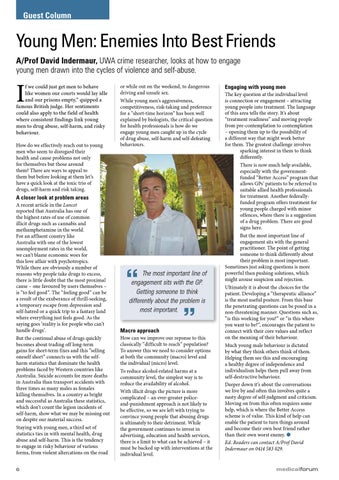Guest Column
Young Men: Enemies Into Best Friends A/Prof David Indermaur, UWA crime researcher, looks at how to engage young men drawn into the cycles of violence and self-abuse.
I
f we could just get men to behave like women our courts would lay idle and our prisons empty,” quipped a famous British judge. Her sentiments could also apply to the field of health where consistent findings link young men to drug abuse, self-harm, and risky behaviour.
How do we effectively reach out to young men who seem to disregard their health and cause problems not only for themselves but those around them? There are ways to appeal to them but before looking at them let’s have a quick look at the toxic trio of drugs, self-harm and risk taking.
or while out on the weekend, to dangerous driving and unsafe sex. While young men’s aggressiveness, competitiveness, risk-taking and preference for a “short-time horizon” has been well explained by biologists, the critical question for health professionals is how do we engage young men caught up in the cycle of drug abuse, self-harm and self-defeating behaviours.
But the continual abuse of drugs quickly becomes about trading off long-term gains for short-term fixes and this “selling oneself short” connects us with the selfharm statistics that dominate the health problems faced by Western countries like Australia. Suicide accounts for more deaths in Australia than transport accidents with three times as many males as females killing themselves. In a country as bright and successful as Australia these statistics, which don’t count the legion incidents of self-harm, show what we may be missing out on despite our material success. Staying with young men, a third set of statistics ties in with mental health, drug abuse and self-harm. This is the tendency to engage in risky behaviour of various forms, from violent altercations on the road 6
The key question at the individual level is connection or engagement – attracting young people into treatment. The language of this area tells the story. It’s about “treatment readiness” and moving people from pre-contemplation to contemplation – opening them up to the possibility of a different way that might work better for them. The greatest challenge involves sparking interest in them to think differently. There is now much help available, especially with the governmentfunded “Better Access” program that allows GPs’ patients to be referred to suitable allied health professionals for treatment. Another federallyfunded program offers treatment for young people charged with minor offences, where there is a suggestion of a drug problem. There are good signs here.
A closer look at problem areas A recent article in the Lancet reported that Australia has one of the highest rates of use of common illicit drugs such as cannabis and methamphetamine in the world. For an affluent country like Australia with one of the lowest unemployment rates in the world, we can’t blame economic woes for this love affair with psychotropics. While there are obviously a number of reasons why people take drugs to excess, there is little doubt that the most proximal cause – one favoured by users themselves – is “to feel good”. The “feeling good” can be a result of the exuberance of thrill-seeking, a temporary escape from depression and self-hatred or a quick trip to a fantasy land where everything just feels good. As the saying goes ‘reality is for people who can’t handle drugs’.
Engaging with young men
The most important line of engagement sits with the GP. Getting someone to think differently about the problem is most important. Macro approach How can we improve our reponse to this classically “difficult to reach” population? To answer this we need to consider options at both the community (macro) level and the individual (micro) level. To reduce alcohol-related harms at a community level, the simplest way is to reduce the availability of alcohol. With illicit drugs the picture is more complicated – an ever-greater policeand-punishment approach is not likely to be effective, so we are left with trying to convince young people that abusing drugs is ultimately to their detriment. While the government continues to invest in advertising, education and health services, there is a limit to what can be achieved – it must be backed up with interventions at the individual level.
But the most important line of engagement sits with the general practitioner. The point of getting someone to think differently about their problem is most important. Sometimes just asking questions is more powerful than pushing solutions, which might arouse suspicion and rejection. Ultimately it is about the choices for the patient. Developing a “therapeutic alliance” is the most useful posture. From this base the penetrating questions can be posed in a non-threatening manner. Questions such as, “is this working for you?” or “is this where you want to be?”, encourages the patient to connect with their core values and reflect on the meaning of their behaviour. Much young male behaviour is dictated by what they think others think of them. Helping them see this and encouraging a healthy degree of independence and individualism helps them pull away from self-destructive behaviour. Deeper down it’s about the conversations we live by and often this involves quite a nasty degree of self-judgment and criticism. Moving on from this often requires some help, which is where the Better Access scheme is of value. This kind of help can enable the patient to turn things around and become their own best friend rather than their own worst enemy. l Ed. Readers can contact A/Prof David Indermaur on 0414 583 029.
medicalforum
